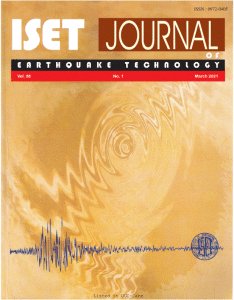Home > Issues & Journals
SEISMIC DESIGN AND SAFETY ASPECTS OF DAMS
A.B. Pandya, S.K. Sibal and B.R.K. Pillai
Paper No.: 528
|
Vol.: 51
|
No.: 1-4
|
December, 2014
|
pp. 1-16

Abstract
The seismic safety of dams has assumed greater importance now because of associated widespread human and economic loss. Strong earthquakes affect large areas, subjecting many dams to strong ground shaking. This is particularly important for Himalayas, where large number of dams have been built or are being built or planned. The 2001 Bhuj earthquake affected about 245 dams, though mainly small dams, but the large scale dam failures calls for review of present design practices. More and more stringent criteria are now being prescribed for seismic design. The earlier methods adopted for seismic analysis of dams are either considered obsolete or even wrong today. There is thus an urgent need for systematic review of existing design techniques and reassessment of seismic safety of existing dams. ICOLD has recently revised its seismic design criteria (Bulletin 148) which are different from the earlier one (Bulletin 72). Also, USACE has also come out with guidelines on seismic design of dams (EM-1110-2-6050, 6051, 6053, etc.). This change shows that dams which were considered safe at the time of completion may not retain that certification even if maintained properly. The National Committee of Seismic Design Parameters (NCSDP) of India is also periodically reviewing its guidelines on seismic parameters to be adopted for dam design based on the state-of-the-art guidelines outlined in ICOLD, USACE and other publications. Dynamic analysis of dams, either using response spectra or time history, has now become almost mandatory for all the dams being designed or planned in India. The seismic coefficient/pseudo static method is considered deficient as it may not satisfy today’s seismic criteria. However, a large pool of experience and performance data of dams exist which were designed by such methods and continue to perform their designed function. Their performance, as viewed from a more rigorous angle leads to additional cost and construction implications. Amalgamation of presently available dam sections with those needed for the modern approach is required so that while not compromising on safety, a panic reaction is also avoided. This paper discusses the present practices on seismic design and performance criteria for dams; conceptual and construction requirement for seismic requirement of concrete gravity and embankment dams and also the need for periodic review of seismic safety of existing dams.
Keywords: Not Available
©2025. ISET. All Rights Reserved.